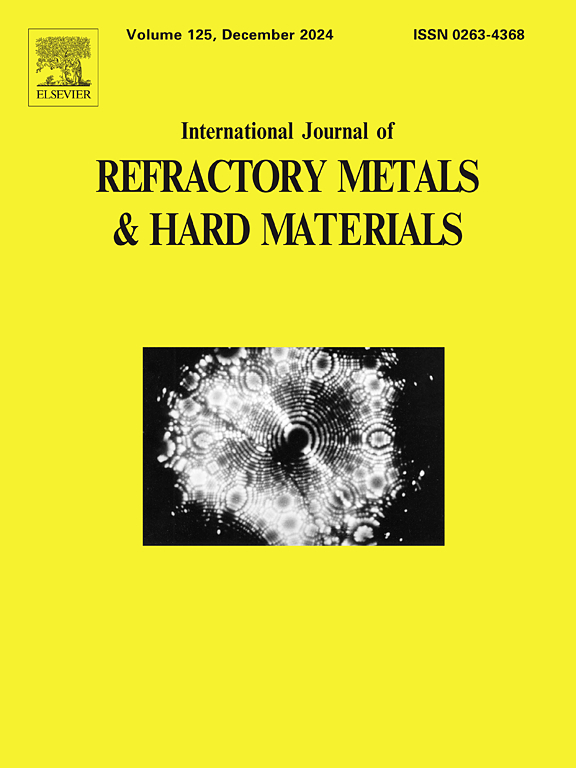Influence of carbon sources on the sintering processes, microstructures, and mechanical proprieties of TiB2-reinforced ultrafine Ti(C,N)-based cermets fabricated via reactive spark plasma sintering
IF 4.2
2区 材料科学
Q2 MATERIALS SCIENCE, MULTIDISCIPLINARY
International Journal of Refractory Metals & Hard Materials
Pub Date : 2025-03-21
DOI:10.1016/j.ijrmhm.2025.107159
引用次数: 0
Abstract
TiB2-reinforced ultrafine Ti(C,N)-based cermets are fabricated via reactive spark plasma sintering. This study investigates the effect of carbon sources on the sintering processes, microstructures, and mechanical properties of cermets derived from a Co-Ni-Y-Ti-BN-WC-VC-Mo2C-TaC-C system. Results reveal that the sintering process involves both solid-state reactions and liquid-phase sintering stages. Compared to graphitic graphite and graphene, amorphous carbon black and nanocarbon exhibit higher reactivity and smaller particle sizes. This characteristic inhibits the Co![]() Ti and Ti
Ti and Ti![]() Ni reactions but promotes the Ti-BN reaction, thereby reducing the shrinkage rate during the solid-state reaction stage. During the liquid-phase sintering stage, carbon dissolves into the molten metal and subsequently diffuses into preformed TiN to create Ti(C,N). The use of carbon black and nanocarbon facilitates greater consumption of carbon. Consequently, there is an increase in shrinkage rate during this stage, a reduction in residual carbon within the final sintered samples, and an enhancement in relative density. Moreover, C atoms present in the liquid phase would promote the diffusion of heavy metals into Ti(C,N). When graphite or graphene is used as a source of carbon, Ti(C,N) with a black core/Gy rim structure is obtained. In contrast, employing carbon black or nanocarbon encourages the diffusion of heavy metals toward the center of Ti(C,N). This behavior contributes to the achievement of weak core/rim-structured Ti(C,N) and coreless solid solution particles with finer particle sizes, respectively. As a result of these processes, the synthesized cermet attains an optimal hardness of 2145 HV and KIC of 7.67 MPa·m-1/2, along with a minimal wear depth of 8.19 μm.
Ni reactions but promotes the Ti-BN reaction, thereby reducing the shrinkage rate during the solid-state reaction stage. During the liquid-phase sintering stage, carbon dissolves into the molten metal and subsequently diffuses into preformed TiN to create Ti(C,N). The use of carbon black and nanocarbon facilitates greater consumption of carbon. Consequently, there is an increase in shrinkage rate during this stage, a reduction in residual carbon within the final sintered samples, and an enhancement in relative density. Moreover, C atoms present in the liquid phase would promote the diffusion of heavy metals into Ti(C,N). When graphite or graphene is used as a source of carbon, Ti(C,N) with a black core/Gy rim structure is obtained. In contrast, employing carbon black or nanocarbon encourages the diffusion of heavy metals toward the center of Ti(C,N). This behavior contributes to the achievement of weak core/rim-structured Ti(C,N) and coreless solid solution particles with finer particle sizes, respectively. As a result of these processes, the synthesized cermet attains an optimal hardness of 2145 HV and KIC of 7.67 MPa·m-1/2, along with a minimal wear depth of 8.19 μm.
碳源对反应放电等离子烧结tib2增强超细Ti(C,N)基陶瓷烧结工艺、显微组织和力学性能的影响
采用反应放电等离子烧结法制备了tib2增强超细Ti(C,N)基陶瓷。本研究考察了碳源对Co-Ni-Y-Ti-BN-WC-VC-Mo2C-TaC-C体系陶瓷烧结过程、显微组织和力学性能的影响。结果表明,烧结过程包括固相烧结和液相烧结两个阶段。与石墨石墨和石墨烯相比,非晶炭黑和纳米碳具有更高的反应性和更小的粒径。这种特性抑制了CoTi和TiNi反应,但促进了Ti-BN反应,从而降低了固相反应阶段的收缩率。在液相烧结阶段,碳溶解到熔融金属中,随后扩散到预成形的TiN中,生成Ti(C,N)。炭黑和纳米碳的使用促进了更多的碳消耗。因此,在这一阶段收缩率增加,最终烧结样品中的残余碳减少,相对密度增强。此外,液相中存在的C原子会促进重金属向Ti(C,N)扩散。当石墨或石墨烯作为碳源时,可以得到具有黑核/Gy环结构的Ti(C,N)。相反,使用炭黑或纳米碳会促进重金属向Ti(C,N)中心扩散。这种行为有助于获得颗粒尺寸更细的弱核/边缘结构Ti(C,N)和无核固溶体颗粒。结果表明,该陶瓷的最佳硬度为2145 HV, KIC为7.67 MPa·m-1/2,最小磨损深度为8.19 μm。
本文章由计算机程序翻译,如有差异,请以英文原文为准。
求助全文
约1分钟内获得全文
求助全文
来源期刊
CiteScore
7.00
自引率
13.90%
发文量
236
审稿时长
35 days
期刊介绍:
The International Journal of Refractory Metals and Hard Materials (IJRMHM) publishes original research articles concerned with all aspects of refractory metals and hard materials. Refractory metals are defined as metals with melting points higher than 1800 °C. These are tungsten, molybdenum, chromium, tantalum, niobium, hafnium, and rhenium, as well as many compounds and alloys based thereupon. Hard materials that are included in the scope of this journal are defined as materials with hardness values higher than 1000 kg/mm2, primarily intended for applications as manufacturing tools or wear resistant components in mechanical systems. Thus they encompass carbides, nitrides and borides of metals, and related compounds. A special focus of this journal is put on the family of hardmetals, which is also known as cemented tungsten carbide, and cermets which are based on titanium carbide and carbonitrides with or without a metal binder. Ceramics and superhard materials including diamond and cubic boron nitride may also be accepted provided the subject material is presented as hard materials as defined above.

 求助内容:
求助内容: 应助结果提醒方式:
应助结果提醒方式:


